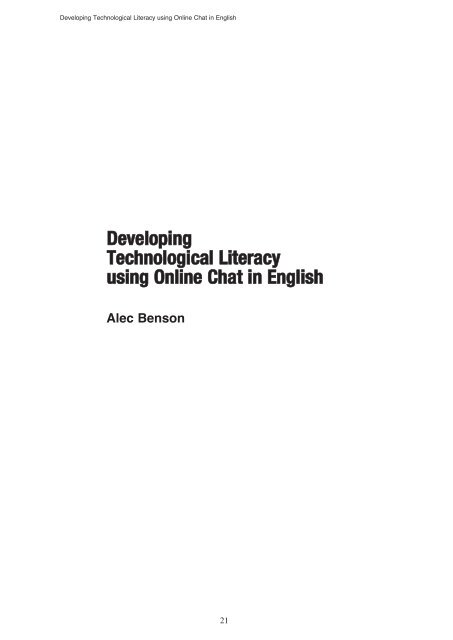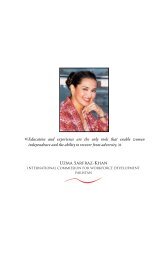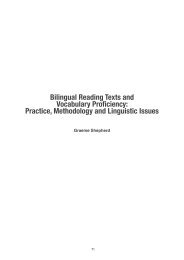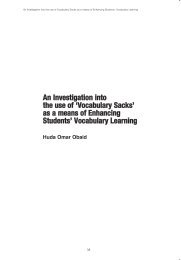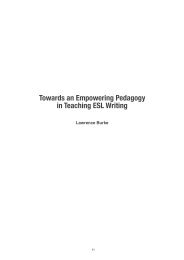Download Full Article - HCT Marifa
Download Full Article - HCT Marifa
Download Full Article - HCT Marifa
Create successful ePaper yourself
Turn your PDF publications into a flip-book with our unique Google optimized e-Paper software.
Developing Technological Literacy using Online Chat in English<br />
Developing<br />
Technological Literacy<br />
using Online Chat in English<br />
Alec Benson<br />
21
Alec Benson<br />
Alec Benson, taught in Al Ain and Ras Al Khaimah<br />
Colleges from 1999 to 2007. He left to continue<br />
doctoral studies and to work in the University of York<br />
in England. He taught English and is interested in<br />
developing students independence and use of<br />
WebCT. This paper resulted from a presentation to<br />
the Blackboard Europe Conference in February<br />
2007. It is based on work with Al Ain Women's<br />
College students in the first semester of 2006-2007.<br />
22
Developing Technological Literacy using Online Chat in English<br />
Introduction<br />
The future for the United Arab Emirates includes creating a knowledge-based and<br />
technological society, so a key role for English language will be to support effective use<br />
of computers. Indeed, <strong>HCT</strong>'s Graduate Outcome One (GO 1), Communication and<br />
information literacy, and Graduate Outcome Four (GO 4), Technological literacy, each<br />
require competence in Information Technology (IT). This paper analyses the use of<br />
synchronous communication (IT-mediated chat) in order to develop student familiarity<br />
with IT and student effectiveness in speaking and writing. A social constructivist view<br />
(Jonassen, Howland, Moore and Marra 1999) of IT is taken, and students' language<br />
production is analysed using a systemic functional approach (Halliday 1985). A<br />
qualitative analysis is also considered using Bachman and Palmer's (1996)<br />
communicative testing framework. The article explains how and why chat in WebCT can<br />
add to the repertoire of procedures to aid student learning and can contribute to the<br />
eventual achievement of the <strong>HCT</strong> Graduate Outcomes.<br />
Working Towards Graduate Outcomes<br />
The former director of the World Bank, Bruno Lanvin, stated recently that<br />
future jobs, productivity, creativity, competitivity and wealth creation will depend on<br />
information technology (Lanvin 2007). He pointed out that education has to acquire<br />
value and content in order to diversify economies, and the engine of globalization is<br />
technology. Computer usage has to go beyond standard software and to have the<br />
capability of incorporating an ever greater percentage of the population.<br />
These ideas are evident in <strong>HCT</strong>'s Graduate Outcomes, the first of which states, in<br />
section 1.1, that graduates "demonstrate an appropriate level of competence in ...<br />
communicating information, opinions, concepts and ideas effectively in English through<br />
both spoken and written media to a variety of audiences" (<strong>HCT</strong> 2006:14) Similarly, GO<br />
4 concerns the use of technology, and specifically, GO 4.2 outlines that graduates need<br />
“an appropriate level of competency in ….using technology to perform effectively in their<br />
personal and professional lives"<br />
<strong>HCT</strong> already uses Web Course Tools (WebCT) as its preferred learning management<br />
system and whilst many online courses available to students are creative, a large<br />
number of such courses merely use the software to present information in a new way.<br />
In effect, students have the textbook on their monitors and so still have to learn from the<br />
textbook and from the teacher. However, a social constructivist view of learning would<br />
suggest that students must learn with the computer, not from the computer (Jonassen<br />
et al 1999). Meaningful learning comes through interaction with people and the<br />
development of shared knowledge. In an ever-changing world, knowledge is not gained<br />
from the teacher or the textbook but is found, developed, evaluated and analysed so<br />
that it can become personalised and "deep", rather than “surface” knowledge. Deep<br />
knowledge is going to be accessed and used in the future.<br />
23
Alec Benson<br />
The Challenge<br />
Teachers in <strong>HCT</strong> are expected to develop information literacy, English language skills<br />
and create a learning environment that prepares graduates for future employment or<br />
leisure activities. In reality, though, students can become bored in English courses since<br />
they have studied it for many years, have possibly reached a plateau of learning, and<br />
may well be accustomed to teacher-centered classrooms, rote memorisation and the<br />
fulfillment of exam or teacher tasks leading to a pass. As a result, students can be<br />
under-motivated and see little benefit to the learning process. In addition the exam<br />
system does not encourage broader learning objectives.<br />
The Response<br />
In order to inspire a class of low intermediate students, I decided to use synchronous<br />
communication, chat, to develop broader English language skills that I felt were lacking<br />
in my students. It is all too easy for English to be seen as an exam subject rather than<br />
a means for communication.<br />
WebCT offers chat as one option for communication. However, many teachers view<br />
chat as something they try to stop students from doing (for example Richardson (2001:<br />
8) complains about chat in Abu Dhabi Women's College), but I feel purposeful chat has<br />
pedagogic benefit. In the early days of networked computers synchronous<br />
communication (chat), researchers found that this activity stimulated students, allowed<br />
quieter students the chance to participate, and had a focus that is absent from face-toface<br />
conversation and teacher-controlled writing classes (Bump 1987, Kelm 1995,<br />
Beauvois 1992, Underwood 1984, Chun 1994, Kern 1995 and Warschauer 1996). It is<br />
worth analysing in more detail what is going on when synchronous communication<br />
takes place.<br />
The online chat process requires students to use the target language extensively and<br />
creatively. Students read, think, formulate, write and send messages to be read by<br />
other students in the class during the chat session. During such activities, language is<br />
acquired through use rather than learnt, grammar is used and therefore implicit, student<br />
contributions are original and thus "authentic". This is motivating for students as it<br />
develops fluency and accuracy on topics that they are interested in. Students who feel<br />
marginalised and who have no voice in face-to-face classrooms can interact and see<br />
value in their contributions. Nowadays most students and teachers have experience of<br />
chat and perhaps view it as a fun activity which detracts from learning. However, in a<br />
second language the mode offers a better pace to develop interactions. The new<br />
medium of chat changes the instructor role to one of facilitator and equal participant,<br />
typical classroom roles of "loud" and "quiet" are changed to roles based on typing speed<br />
and clarity and quality of thought. Students cannot be interrupted while typing so chunks<br />
of language, whether vocabulary or structures, can be attempted and then reviewed.<br />
The vibrancy of online chat means that grammar has to reflect Halliday's (1985)<br />
approach of systemic functional grammar because language is actively used as a<br />
network of grammar systems. Halliday suggests that language is functional, in having a<br />
use, and meanings are important. At the same time, meaning does not have to be<br />
24
Developing Technological Literacy using Online Chat in English<br />
sentence level, as vocabulary and grammar function within a system of meaning and<br />
comprehension. Certainly, our students may have experienced or learnt 'school' English<br />
which was aimed at correctness or 'display' of specific vocabulary or grammar, but they<br />
have not really used English. The choice of structural and lexical options when chatting<br />
produces meaning and communication. Grammar, which can include lexical<br />
appropriacy, becomes the resource that enables participants in the online environment<br />
to construct meaning. The chat environment forces students to actively deal with field,<br />
tenor and mode changes, where field refers to what is happening, tenor to who is taking<br />
part and mode to the function of language (Halliday and Hasan 1985: 12). In most<br />
language teaching situations these are controlled and hence our students become<br />
overwhelmed by genuine and authentic situations where they are unsure about what is<br />
happening, and cannot achieve the communicative goals they would like. I therefore<br />
suggest online chat gives practice that will enable effective communication skills.<br />
Social constructivism (Jonassen et al 1999) suggests that human knowledge is natural<br />
and clear to those who have been trained and inculcated into it, and consequently<br />
knowledge is the invention of the particular culture. In education, course designers need<br />
to be aware that human action shapes technology but this does not mean that online<br />
courses should feed students the textbook in an alternative mode. Instead students<br />
should develop knowledge by using technology to interact with each other and to<br />
construct group language, ideas, grammar and lexis. In particular, online chat offers<br />
social actors symmetry and equal participation rights in the construction of language<br />
and thought.<br />
Casual conversation can seem trivial, but it is a difficult skill for our students to build.<br />
Using Bachman and Palmer's (1996: 63) outline for language use, we can suggest that<br />
the students' strategic competence is affected by topical knowledge, language<br />
knowledge and personal characteristics. Language knowledge can be divided into<br />
organizational knowledge of grammar, vocabulary, syntax, phonology, graphology and<br />
also important in online chatting is a knowledge of rhetorical organization. As chatting<br />
involves communication goals, students need to know how to manipulate language in<br />
order to get people to do things, to control the flow of ideas and most importantly to use<br />
interpersonal functions effectively. Examples of interpersonal functions would be<br />
greetings, compliments, insults, humour and so on which our students need to perform<br />
in English.<br />
Examples<br />
In order to illustrate how relevant chat can be to language learning, I will use<br />
anonymised excerpts taken from the chat log. I will look at greetings and farewells,<br />
enquiries, humour, stories, candid truths and also the problem of 'flaming' which is<br />
aggressive behaviour online designed to intimidate others.<br />
After the first chat session I looked at the script and saw greetings and farewells like<br />
these:<br />
"hi every bady", "hi evrey bady", "hay", "bye banat", "bay shabab", "I whcic to chat with<br />
you again", "good good good bay".<br />
This transcript revealed that students lack practise at both greetings and farewells.<br />
Basically greetings are taught in the first few classes and then in the teacher controlled<br />
25
Alec Benson<br />
classroom the teacher says "good morning" and the students may or may not answer.<br />
Similarly, once the class ends, students and teachers head for the door muttering "see<br />
you". Online chat analysis revealed that my students would not fulfil social norms in<br />
greeting people, whether face-to-face or online. Given such poor first impressions,<br />
listeners are likely to hold a low opinion of our graduates' language abilities.<br />
In the next few chat sessions I added more to my greetings rather than trying to get the<br />
students on to the tasks and I lingered on farewells, so I had better results after a few<br />
weeks:<br />
"Hi everybody", "hi mariam how are you", "Hi Girls", "How are you today", "Goodbay<br />
goodbye", "b'bye", "I liketo say bay, bye sir", "okay b'bye", "see you on Tuesday".<br />
In a similar way, the students' weaknesses in asking questions were evident. In most<br />
classes the teacher controls the conversation and so asks questions, with the result that<br />
students have difficulty asking questions and particularly do not ask each other<br />
questions. In the online world, the change in teacher role to one of an observer and<br />
equal participant means that students can ask each other and have to deal with the<br />
consequences. As an example, consider this exchange which appeared during chat<br />
about weekend plans:<br />
Student 1<br />
Student 2<br />
Student 1<br />
Student 2<br />
Student 1<br />
Student 2<br />
Student 1<br />
I will go to visit my mother<br />
Wher is your mother<br />
She don't live with me<br />
It's ok<br />
I live with my father<br />
I am sorry dear<br />
it's Ok...I took withe her evrey day<br />
Student 2 is surprised because Student 1 is doing something (seeing her mother) that<br />
is unusual for Student 1 but very normal for Student 2. One of the problems with asking<br />
questions is of becoming nosy and transgressing social norms, so Student 2 tries to get<br />
out of the question and to apologise for being too inquisitive. She clearly has difficulties<br />
with social English. Student 1's phrase "I took withe her" needs to be understood as "I<br />
talk to her". Student 1 was open about her family situation and this is a feature of online<br />
chat; the mode allows a safe and a secure environment (at least, it seems to be only<br />
visible to other students and the trusted teacher) so students reveal things that they<br />
would not tell normally. For example, the following occurred during chat about names:<br />
when i born my ancle come and he say for my father choes name _______ for your<br />
baby because i want to marry her for my sun<br />
Amidst the grammar and the spelling mistakes, Student 3 has revealed that her name<br />
was chosen by her uncle because she would be his daughter-in-law. Clearly, Student 3<br />
is caught up in the desire to communicate using the online mode and so reveals some<br />
personal detail. In addition, she went on to mention that her family often call her Mariam<br />
because that would have been her name before her uncle's suggestion.<br />
Another example, this time from the topic of schooling, also revealed that strong<br />
feelings are raised:<br />
26
Developing Technological Literacy using Online Chat in English<br />
when i was in the school i hit a zalamat teachers<br />
This student has a phonetic-grammar confusion: she means to say "hate" but she<br />
probably hears "hit" and so makes the past of "hit”. She wants to express that she hated<br />
"Zalamat" teachers, or teachers from rural areas of Lebanon, Syria and Jordan. Her<br />
comment led to discussion, negation, negotiation, some irritation at her revelation and<br />
then clarification as to meaning.<br />
Conversation cannot always be serious and if we are to enjoy chatting there has to be<br />
some comedy. Humour is difficult in a foreign language and the first example, coming<br />
from a chat session about childhood reveals this:<br />
i never give the boys my toys only girls because the boys are gosts<br />
This is an Arabic women's joke, based on the traditional white dishdasha worn by Arab<br />
men. It is not a particularly funny joke, but most people trying to raise a laugh in another<br />
language will translate from L1. It can be much harder to make a joke that makes sense<br />
in only one language, but during a chat session on the controversial Lebanese reality<br />
show "Star Academy", a student contributed:<br />
i think some people are star acadenyholic<br />
So based on workaholic, chocoholic and alcoholic the student has created a pun in<br />
English.<br />
In addition to developing speaking skills, chat can be used to develop writing skills and<br />
whilst we were working on the topic of childhood memories a student wrote:<br />
… my friend and i decided to played a joke, unfortuntely my friend took the joke<br />
seriously then she cut my long hair, Afterthat when my mother saw me she punished<br />
me and she didn't allowed me to went with her again<br />
The story concerned a bet which she lost and so had to cut her hair. This student used<br />
the chat session to reflect on an event, to try to explain it and to entertain the audience.<br />
Similarly another student, who began her story hesitantly and uncomfortably, revealed<br />
that she had asked for a chick on a farm visit when she was a child. She took the chick<br />
home and broke its neck and asked her mother for a new one. The class showed shock<br />
at this story. We were later able to correct the stories using the transcripts and produce<br />
these original, authentic, past tense stories as essays. I have no way of knowing if these<br />
students will ever use the story with its acquired grammar and vocabulary but if they did<br />
it would mean that the examiner is getting a more engaging tale of Emirati childhood<br />
memories.<br />
Unfortunately neither face-to-face nor online communication is always rosy, and I had<br />
some examples of flaming. Firstly, a conversation on children led to presents for<br />
children, then punishments for children, at which point one wrote that she had had to<br />
clean her room when she had behaved badly. At which point she was flamed:<br />
you know ____ I think your mother should give you avacume as present! So you can<br />
finish your work earlier<br />
27
Alec Benson<br />
The notion of being given a vacuum cleaner as a present is aggressive and really killed<br />
the conversation. In another session one student remonstrated:<br />
the egyption people musn't talk!<br />
As she perceives Egyptians to be dedicated and hard working, the writer wants the<br />
"swot" of the class to be quiet and allow less able students to chat. In both cases, a<br />
student is targeted. These students were unfortunately not "acting ethically when using<br />
technology" as Graduate Outcome 4.3 suggests, but such events of course present<br />
opportunities to learn from mistakes in a relatively safe environment.<br />
Discussion<br />
My procedure with WebCT chat was to prepare a topic by looking ahead in the textbook,<br />
adding appropriate readings as either classwork or homework, revising vocabulary and<br />
grammar. During the chat sessions, which I held every two weeks in class time, I found<br />
that the students were challenged by cohesive elements (field and tenor) in<br />
communication because the mode has threaded conversations that appear in<br />
chronological order. So responses to a posting may appear after a minute or two when<br />
there is another topic. The initial topic also changed; I have to admit that at first I wanted<br />
to keep students on topic, but I soon found that the most productive use of English<br />
language was as the students went off on other topics. As a result, their vocabulary and<br />
grammar resources were tested in impromptu, yet communicatively authentic, ways.<br />
This led to many subsequent questions when the class and I analysed the chat<br />
transcript. Every post-session analysis made students sit forward and explain why they<br />
had written comments and what they really meant.<br />
Before class analysis, the chat transcripts (generated from WebCT) needed to be<br />
cleaned of student names and identification details and this was time consuming. Once<br />
that was achieved, however, there was great class interest in reliving the online<br />
conversations. Students asked questions about vocabulary gaps and circumlocutions,<br />
they quickly clarified typing mistakes versus serious errors in spelling, they saw<br />
phonetic gaps when their spelling revealed they heard and therefore spelt incorrectly.<br />
This mix of speaking and writing revision was also helpful to make me revise my own<br />
teaching materials in order to reflect not just the grammar or vocabulary topics but all<br />
the potential and related grammar and vocabulary that could be needed for successful<br />
online communication. In other words, I had to take a systemic view of grammar<br />
(Halliday 1985).<br />
Reflection<br />
Online contributions resembled "conversation in slow motion" (Beauvois 1992) as the<br />
students could 'speak' slowly but with increasing fluency and accuracy, which is just<br />
what many students need in English. Instead of responding to a textbook or to the<br />
teacher, students responded to each other in a social constructivist way as advocated<br />
by Jonassen et al (1999). There was also authentic communication in that there was<br />
humour, insults, changes of topics and so on, thus better communicative language use<br />
as defined by Bachman and Palmer (1996).<br />
28
Developing Technological Literacy using Online Chat in English<br />
I would also suggest that regular chat sessions developed the generation of ideas,<br />
vocabulary and structures that students need for writing essays. All too often students<br />
do exams "cold" in that they suddenly have to write without time to scaffold or develop<br />
content, structures or vocabulary, but the process of online chatting allowed the<br />
development of ability. A final and unexpected benefit to my students was that of<br />
reading speed. Many of my students still move their lips as they read and this slows<br />
down both the number of words they can read per minute but also hinders<br />
comprehension. The students were very motivated to read peers' messages quickly, to<br />
find the points made and to add their own comments. So they had to read quickly; in<br />
fact there were sometimes shouts in the class begging others to slow down their written<br />
contributions.<br />
Conclusion<br />
A brief summary of my research would suggest that the use of chat within WebCT has<br />
the benefit of motivating both the students and teacher. In many ways the regular use<br />
of chat made me revise my curriculum and course content and that was motivating. It<br />
also raised student awareness of their errors and gave them encouragement when the<br />
communication was successful. Chat develops students IT familiarity and also prepares<br />
them for the kind of technological literacy that is likely to be required in the future. As<br />
an aside, there are already colleges in the <strong>HCT</strong> system that use Windows Messenger,<br />
and other commercial companies use similar instant messaging systems. If <strong>HCT</strong><br />
graduates are to develop technological literacy (GO 4), then they will need training, and<br />
I would suggest easily through WebCT chat, to use "technology to perform effectively<br />
in their personal and professional lives". Chat also develops GO 1, as students build<br />
skills to communicate through written and spoken mediums. By using chat in English, a<br />
safe environment is created in which technological and language skills can be<br />
developed in a fun and yet pedagogically sound way.<br />
References<br />
Bachman, L. and Palmer, A. (1996). Language Testing in Practice, OUP, Oxford.<br />
Beauvois, M. (1992). "Computer-Assisted Classroom Discussion in the Foreign<br />
Language Classroom: Conversation in Slow Motion", Foreign Language Annals 25,<br />
No.5; 455-464.<br />
Bump, J. (1987). "CAI in Writing at the University: Some Recommendations,"<br />
Computers and Education 11,2 (1987), 121-33.<br />
Bump, J. (1990). "Radical changes in class discussion using networked computers",<br />
Computers and the Humanities 24, 49-65.<br />
Chun, D. (1994). "Using Computer Networking to Facilitate the Acquisition of Interactive<br />
Competence", System, Vol. 22, No. 1; 17-31.<br />
Halliday, M. (1985). An Introduction to Functional Grammar, Edward Arnold, London,<br />
UK.<br />
29
Alec Benson<br />
Halliday, M. and Hasan, R. (1985). Language, Context, and Text: aspects of language<br />
in a social-semiotic perspective, OUP, Oxford, UK.<br />
<strong>HCT</strong> (2006) "The <strong>HCT</strong> Learning Model"<br />
Jonassen, D., Howland, J., Moore, J. and Marra, R. (1999). Learning to Solve Problems<br />
with Technology; a constructivist perspective, Merrill Prentice Hall, Ohio, USA.<br />
Kelm, O.R. (1995). "The Use of Synchronous Computer Networks in Second Language<br />
Instruction: A Preliminary Report", Foreign Language Annals 25, No. 5; 441-454.<br />
Kern, R. (1995). "Restructuring Classroom Interaction with Networked Computers:<br />
Effects on Quantity and Characteristics of Language Production", The Modern<br />
Language Journal, 79, iv; 457-476.<br />
Lanvin, B. (2007). Speech to Blackboard Europe Conference, 27 February 2007.<br />
http://www.bbworld07.com/emea/programme_keynote.asp accessed 31/5/2007<br />
Richardson, P. (2001). "New Learning Technologies in an Arab Learning Community: a<br />
UAE case study" <strong>HCT</strong> Journal Volume 5, 1; 5-14.<br />
Underwood, J. (1984). Linguistics, computers, and the language teacher. Rowley,<br />
Mass., Newbury House Publishers, Inc.<br />
Warschauer, M. (1996). "Comparing Face-to-Face and Electronic Discussion in the<br />
Second Language Classroom", CALICO Journal, Vol. 13, Numbers 2 & 3; 7-26.<br />
30


